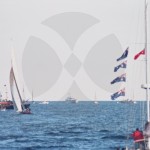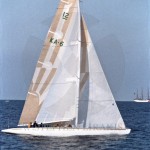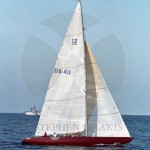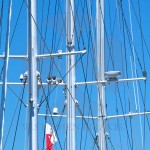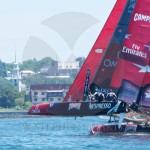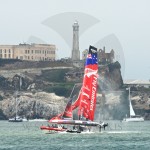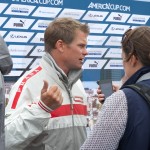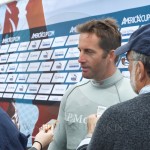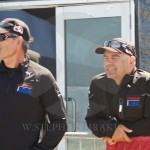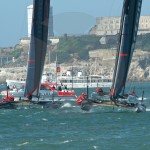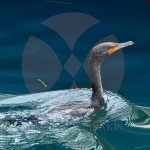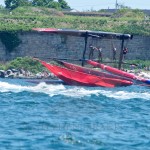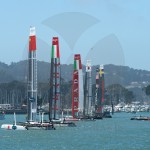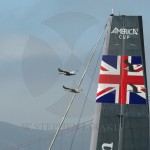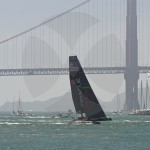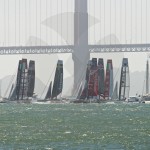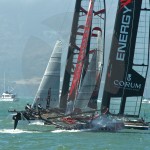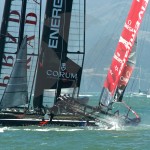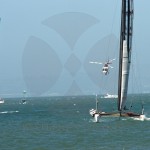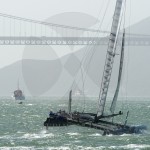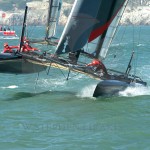I have long believed that there is only one way to learn sailing and that is with another boat near you. Training with a second boat is even better than racing, if you want to learn. Certainly in our college years it is what we did; practice makes perfect, even when you are good.
Tag: america’s cup
SOME DAYS YOU DON’T KNOW WHAT TO POST
LOUIS VUITTON GUIDE TO SAN FRANCISCO
ON THIS DAY IN HISTORY
ON THIS DAY IN HISTORY
The date, 25 September 1983, remains vivid in the memories of Australians
who watched – perched on the edge of their sofas, thrusting into the air
punches of elation – as Australia II crossed the America’s Cup finishing
line at Newport, USA.
It was one of those events where you can remember what you were doing at
the precise moment they saw or heard the good news. And, it moved then
Prime Minister Bob Hawke enough to famously declare: “Any boss who sacks
anyone for not turning up today is a bum.”
Australians love the water, but yachting is not a spectator sport for the
masses. Why then, did the win have such an enormous impact?
John Bertrand, skipper of Australia II and now chairman of the Sport
Australia Hall of Fame, says the many superb performances by Australians –
notably Cathy Freeman’s gold medal sprint in the Sydney Olympics and Kieran
Perkins’ win from lane 8 at the Atlanta Olympics – make it difficult to
choose the ultimate achievement in Australian sporting history.
“We broke 132 years of American domination in winning the America’s Cup –
we’re proud of that!” says John.
It was a glow that was shared by many in the country, and more people chose
to become naturalised Australians shortly after the win, than ever before
or since. John says; “People felt part of this country for the first time.
Certainly there was a great injection of both pride and confidence into the
country.”
What about the controversy surrounding the secret weapon that gave the
Australian yacht its advantage over its American competitor – the upside
down, winged keel?
There has been a perennial argument over whether Australia II should have
been disqualified because the rules specified that competing yachts had to
be designed by residents or citizens of the country they represented. The
Americans alleged, but couldn’t prove, the boat was not
Australian-designed. Then, in 2009, Dutch boat designer Peter van Oossanen
claimed Australian II designer, Ben Lexcen, had minimal involvement in the
keel’s design, and a Dutch team were the true designers.
John claims it’s a technicality. “Success has many fathers; failure has
none,” he says. “To win the Cup required a great deal of work by many
people, but in terms of any controversy, the key was [that] Ben Lexcen was
the chief designer. So under the rules, Australia II was totally legal. Of
course, the America’s Cup rules now don’t even consider nationality.”
Today, Australia II calls home the Western Australian Maritime Museum in
Fremantle.
SAN FRANCISCO HAS HAD A BUSY SUMMER/TEAM KOREA CHANGES
BUSY WEEKEND
Got plans for Columbus Day weekend? The annual anniversary of Christopher
Columbus’s arrival in the Americas, which occurred on October 12, 1492, is
always the second Monday in October. As it’s also a federal holiday in the
U.S., you may be looking at options for a three day vacation. If you are
thinking of San Francisco, rest assured, you are not alone:
October 4-8: A tradition since 1981, Fleet Week is the most anticipated
Fall event in San Francisco. With an estimated audience of 1 million,
spectators are drawn every year to the city’s northern waterfront to be
awed by a parade of Navy ships, along with a spectacular aerial show that
includes the Navy Blue Angels. Also on hand are a variety of other
nighttime entertainment venues that kick off just as the sun sets over San
Francisco Bay.
October 5-7: The 12th annual Hardly Strictly Bluegrass is one of the
largest (and free-est) music festivals in the U.S. Held in Golden Gate
Park, three quarters of a million people are expected for the likes of
Patty Griffin, Les Claypool, Cowboy Junkies, Emmylou Harris, Chuck Prophet,
Chris Robinson Brotherhood, Elvis Costello, Dwight Yoakam, Lloyd Cole,
Patti Smith, Steve Earle, Vince Gill, Nick Lowe and more.
October 2-7: The second event of the 2012-13 America’s Cup World Series
will be sharing the City with the iconic events above. The first America’s
Cup event in San Francisco in August attracted over 150,000 fans to the
Marina Green and nearly 500 spectator boats to witness 11 of the best
sailing crews in the world battle just yards from the shoreline. In
October, the 11 AC45 will return to the Bay in hopes of attracting the
attention of the holiday crowds. Full details:
http://media.americascup.com/pressreleases/?id=928
CHANGES AT TEAM KOREA
(September 20, 2012) – The revolving door marked skipper at America’s Cup
challenger Team Korea is spinning again as Australian Olympic gold medalist
Nathan Outteridge departs after just seven months, about the same tenure as
his predecessor Chris Draper, an Olympic bronze medalist.
Outteridge, who, with crew Iain Jensen, blitzed the 49er fleet in the London
2012 regatta last month, is expected to join one of the three confirmed
challengers for next year’s 34 America’s Cup with the Swedish-based Artemis
as the front runner. Draper is with Italy’s Prada-backed Luna Rosa
challenge. The third is Emirates Team New Zealand.
The imminent official announcement by Korea team boss Dong-Young Kim, which
will name Outteridge’s successor, may also be coupled with final
confirmation that Team Korea is putting its current Cup challenge on hold,
though it has paid the $200,000 entry fee, and aiming at AC35.
But the cost of mounting a viable challenge in the new class of 72-foot
wing-powered catamarans is upwards of $100m. So far Team Korea, which also
has links with English premier league soccer club Sunderland, has failed to
announce that it has raised any significant budget. Among the Team Korea
crew in Naples, Venice, Newport, Rhode Island, and San Francisco this year
have been three top British talents, Giles Scott, Mark Bulkily, and Matt
Cornwell.
Announcing a new skipper implies that Team Korea will race at the America’s
Cup World Series regatta in San Francisco early next month. If so, the crew
will then need to be confirmed. — Full story at: http://tinyurl.com/d92zz36
The ACWS race schedule has had to work around the Fleet Week activities.
The Cup Experience website provides some clarity on how the events will
merge: http://tinyurl.com/CE-091912
LOOKING BACK AT SUMMER
It is after labor day, the unofficial end of summer, and the beginning of school, or at least it used to be. The Olympics took place this summer and the America’s Cup is heating up. There is no shortage of Olympic sailors in the America’s Cup.
If you are a sailor and an American, you were stunned to see that the US did not medal in a single class, not even in the hunt.
ISAF, the governing body of sailing is so politically charged, it is often hard to understand if the right thing happens or could happen.
If the Olympics wanted to truly limit costs and open the possibility of more good sailors; there is a solution: model the sailing after college sailing. The host country would select a boat, doesn’t matter which. They would build a fleet which could be sold at the end of the event.
The sailors would race against each other in these boats, rotating after every race. This is level racing, with little room for anything else.
The America’s Cup is a development event. It is intended to foster faster sailing boats. The Event in 1851 was conceived to showcase naval architecture.
REMINDS ME OF SOMEONE
Very cute, The America’s Cup takes itself so seriously, this video is frankly a relief. I have known more than one designer/engineer who would think to do the same thing.
COSMIC SHIFT
Hydropetiere set the new standard. Foils are in. To go fast you must reduce wetted surface. Will SpeedDream work as hoped? No matter what sailing has changed dramatically in my lifetime. And the change has accelerated.
Oracle’s L-foil failure on their AC72’s first day out was no minor snafu. With nearly a two-month build time for the hyper-engineered appendages, their engineers and designers must be freaking out right now trying to understand exactly how and why such an important structure broke. With the foil carrying more than half the weight of the boat in fully foiling conditions, it’s akin to a brand new Formula One car losing its front wheels on the first-ever test lap. Like Artemis’ expensive and time-consuming wing failure and repair, Oracle could be looking at the loss of a ton of development time exactly when they need it most: When the breeze is pumping through the Golden Gate. We’ll see what the spare looks like – it’s very easy to stay posted on the up-to-the-minute action with all the boats here.
ETNZ seems to be getting the most out their Auckland testing with minimal drama, but it’s worth noting that these boats are all just one bad decision away from having a long repair bill, especially when they’re doing 40 knots, 4 feet above the water’s surface, held up by just two tiny blades of carbon. For anyone still wondering if ‘fully foiling’ is nothing but a head fake, we turn to resident C-Class mastermind ‘blunted’ – who’s been down the foiling road before with the C-boat Off Yer Rocker.
Clean speculated once that we built ‘off yer rocker’ as a head fake. Well if it was, it was a really expensive practical joke, on us. Suffice to say it was not intended that way by our team. We were chasing some very “real” benefits on the course. We just did it wrong.
I’ve never really said it publicly till now, ‘cause everyone knows I am “the wing nut” and I get all hot and bothered about wings, but from about 4 seconds after the AC72 rule was cast everyone who was anyone knew the design race would be won in the water with foils, not in the air with wings. You only need to look at a few rudimentary VPP graphs to see the difference between foiling and floating to know that you want to fly as much boat as you can, because the drag goes up so fast in float mode and it goes up a lot slower in foiling mode. The big problem is control, because the Rule does not allow actuated surfaces [like a moth’s flaps –ed] to control ride height you have to figure out how to manage the whole package to keep it on its feet, in a safe enough mode you can put your foot on the pedal.
We went back to traditional in the C for a couple of reasons; the biggest being that it didn’t work in our chosen configuration. I am not convinced the C-cat has enough power to make it work well enough at all, at least for Fredo and I, cause of how we like to sail the boat downhill. The 72’s can unfurl a nice big code zero and that offers a lot of power to get up on the foils efficiently, now the trick is to ride a bike with no handlebars so to speak. Foiling without automatic ride height control really is, “Look ma, no hands!”
My guess is the focus on foiling will be downhill as upwind they may have to trade away too much righting moment to make it worth it. I haven’t seen any real numbers recently so it’s difficult for me to say either way. For righting moment remember that your foil as it kicks in essentially moves the center of floatation of the hull towards the middle of the foil. When 100% up on a foil the boat is rotating around a point between the middle of the upright foil and the horizontal foil, well below and inside the center of actual buoyancy. As such you lose some leverage and therefore lose righting moment so you can apply a bit less power, so the trade off needs to be worth it to go for it.
So yes, my vote is anybody who is serious will be foiling, as soon as they are going downhill.
09/04/12

